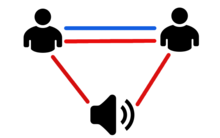

An interest graph is a digital portrayal of an individual's specific interests.[1] Its perceived utility and value stem from the premise that a person's interests form a significant component of their personal identity. They can be used as indicators of various aspects, such as a person's preferences regarding activities, purchases, destinations, as well as who they may choose to meet, follow, or support politically.[2]
YouTube Encyclopedic
-
1/3Views:1 7067 33111 305
-
graphing simple interest
-
The Power of Compound Interest in 3 Graphs
-
Modelling Compound Interest in Desmos
Transcription
Relationship of interest graph to social graph
Interest graphs and social graphs are closely related, but they are not synonymous.[3] Where Facebook and other social networks are organized around an individual's friends or social graph, interest networks are organized around an individual's interests, which are represented as an interest graph.[4][5]
Both graphs extend across the web, with social graphs serving as maps of a person's social media connections, and interest graphs as mappings of an individual's interests. In this way an individual's interests represented in an interest graph provide a means of further personalizing the web[6] based on intersecting the interest graphs with web content.
Interest graphs or interest networks can in some cases be derived from social graphs or social networks and may maintain their context within that social network.[7] These are specifically social interest graphs or interest-based social graphs.[8][9]
For an interest graph to be accurate and expressive, it must consider explicitly declared interests, for example "Likes" on Facebook or “Interests” in a LinkedIn profile, as well as implicit interest inferred from user activities such as clicks, comments, tagged photos and check-ins.[10] Social networks are often a source for this data.[11][12]
Uses of interest graph
There are several personal and commercial uses for interest graphs. They can be applied in conjunction with social graphs as a way to meet or connect with people in a social network or community with shared or common interests, and who may not otherwise know each other.[7][13]
Interest graphs can also be applied to marketing for purposes such as audience analytics and audience-based buying,[14] for sentiment analysis,[15] and for advertising as another form of behavioral profiling and targeting based on interests.[7][11] Companies like Twitter, for example, use interest graphs to specifically target advertisements to their users based on their interests.[16] Interest graphs may be applied to product development by using customer interests to help determine which new features or capabilities to provide in future versions of a product.[5]
Interest graphs have many other uses as well,[12] including simulation,[17] research and other content discovery and filtering tasks,[18] as input to recommendation engines for films, books, music, etc.,[19] and for learning and education.[20]
See also
References
- ^ rr11. "How the Interest Graph will shape the future of the web" Archived 2015-03-20 at the Wayback Machine, MIT Entrepreneurship Review, Cambridge, 1 April 2011. Retrieved on 11 March 2013.
- ^ Tullman, Howard A. "Where Social Media Will Take Us in 2013", Inc.com, 28 December 2012. Retrieved on 11 March 2013.
- ^ Miller, Paul. "Radar Networks opens Twine to the world with version 1.0", ZDNet, 20 October 2008. Retrieved on 14 March 2013.
- ^ Jamison, Jay. "Three Reasons to Watch Interest-Based Social Networks in 2013", All Things D, 28 December 2012. Retrieved on 11 March 2013.
- ^ a b Firuta, Jakub. "How to create an Interest Graph", LiveChat, 12 July 2012. Retrieved on 17 July 2012.
- ^ Harris, Derrick. "The personalized web is just an interest graph away", GIGAOM, 15 March 2012. Retrieved on 11 March 2013.
- ^ a b c Hossain, Nadim. "Why the Interest Graph Is a Marketer’s Best Friend", Mashable, 19 June 2012. Retrieved on 17 July 2012.
- ^ Perez, Sarah. "Formspring Relaunches As an Interest-Based Social Network", TechCrunch, 19 June 2012. Retrieved on 11 March 2013.
- ^ Jamison, Jay. "Beyond Facebook: The Rise of Interest-Based Social Networks", TechCrunch, 18 February 2012. Retrieved on 11 March 2013.
- ^ Jurka, Tim. "A Look Behind the AI that Powers LinkedIn’s Feed: Sifting through Billions of Conversations to Create Personalized News Feeds for Hundreds of Millions of Members". LinkedIn, 29 March 2018.
- ^ a b Rashad, Moataz. "5 Key Components of a Successful Interest Graph". Mashable, 21 February 2012. Retrieved 27 November 2012.
- ^ a b Rogers, David. "The Future of the Social Web: Social Graphs Vs. Interest Graphs", ReadWriteWeb, Boston, 30 September 2011. Retrieved on 7 February 2012.
- ^ PRWeb. "Cupid’s New Canoodle Finds People Who Like What You Like", PRWeb, 1 December 2012. Retrieved on 11 March 2013.
- ^ Mims, Christopher. "Yahoo’s plan for a turnaround: juice its advertising revenue by reading your mind", Quartz, 23 October 2012. Retrieved on 11 March 2013.
- ^ WebProNews Staff. "The Era of the Interest Graph: Studying The Top Starbucks Followers", WebPro, 8 February 2011. Retrieved on 11 March 2013.
- ^ Perez, Sarah. "How Twitter Is Pairing Its Interest Graph With Ads", TechCrunch, 1 March 2012. Retrieved on 17 July 2012.
- ^ Sweeney, Peter. "Five Surprising Ways to Use Interest Graphs", Primal, 28 May 2012. Retrieved on 11 March 2013.
- ^ Ingram, Mathew. "Why a LinkedIn acquisition of Pulse would make sense — content requires context", paidContent, 12 March 2013. Retrieved on 13 March 2013.
- ^ O’Dell, Jolie. "What the heck is an interest graph? Pearltrees raises $6.6M to show us", VentureBeat, 13 February 2012. Retrieved on 11 March 2013.
- ^ Feldstein, Michael. "Desire2Learn Mobile Contest Winners", e-Literate, 16 September 2012. Retrieved on 11 March 2013.
